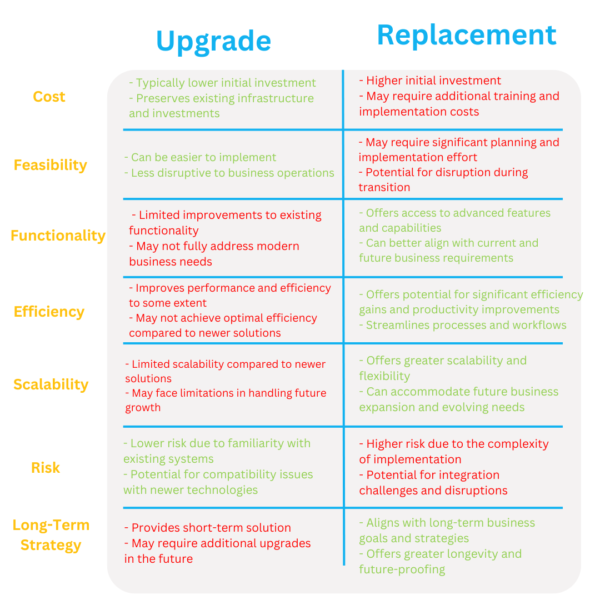
Integrating legacy systems into SAP projects presents a similar situation – a delicate balance between preserving the familiarity of existing systems and embracing the transformative power of modern technology. Ultimately, many businesses must carefully blend legacy systems with updated programs through providers such as SAP to create a recipe for success. In this guide, we’ll uncover the ingredients for successful integration even with legacy systems.
Legacy System Assessment:
When integrating SAP into your organization, you first need to assess your existing legacy systems.
Identify Critical Components: Begin by identifying the key elements within your legacy infrastructure. This includes pinpointing critical data, applications, and processes that are vital to your business operations. Understanding what you have and how it functions is essential for a smooth integration process.
Evaluate Compatibility: Assess the compatibility of your legacy systems with SAP requirements. Look for potential mismatches in data formats, software dependencies, and system architectures. Understanding where compatibility issues exist will help you anticipate integration challenges and develop mitigation strategies.
Assess Integration Challenges: Determine the extent of integration challenges posed by your legacy systems. Identify areas where data may need to be migrated or transformed to align with SAP standards. Anticipate potential roadblocks such as data inconsistencies, software limitations, and process inefficiencies.
Identify Improvement Opportunities: Use the assessment process to identify areas for improvement within your legacy systems. This could involve streamlining processes, updating outdated software, or improving data quality. By addressing these areas proactively, you can optimize your legacy systems for seamless integration with SAP.
Develop a Roadmap: Based on your assessment findings, develop a roadmap for integrating SAP with your legacy systems. Outline specific steps, timelines, and resource requirements for each phase of the integration process. Having a clear plan in place ensures a structured and successful transition to SAP.
By conducting a thorough assessment of your legacy systems, you lay the groundwork for a successful SAP integration. Understanding the current state and functionality of your existing infrastructure allows you to anticipate challenges, identify improvement opportunities, and develop a strategic roadmap for integration.
Legacy System Modernization:
In today’s rapidly evolving technological landscape, the modernization of legacy systems has become a pressing concern for many organizations. Here’s a closer look at how to approach this critical aspect of your digital transformation journey:
Evaluate Upgrade vs. Replacement: When considering modernization options, the business must first decide whether to upgrade existing systems or replace them entirely with newer solutions. To do this, evaluate the pros and cons of each approach, considering factors such as cost, feasibility, and impact on business operations. Upgrading existing systems may offer cost savings and preserve existing investments, while replacing them with newer solutions could provide greater functionality and efficiency.
A contribution by Pratt discusses further the decision of whether to maintain or replace legacy systems.1 While outdated hardware, security risks, and digital transformation initiatives may prompt replacement, existing systems can remain if they are reliable. IT leaders should carefully assess the benefits and challenges of both options and consider modernization as an alternative.
Michael Bradshaw’s approach at Kyndryl involves a strategic assessment of existing systems, aiming to streamline modernization efforts by digitizing the business chain. In his approach, prioritizing business needs and competitive advantage helps determine which systems to modernize first. Factors such as cybersecurity concerns, maintenance requirements, and operational costs also guide the decision-making process.
Ultimately, legacy systems can hinder innovation efforts and pose security risks, making modernization a priority for some organizations. Key reasons to replace legacy systems include unacceptable security risks, performance hindrances, misalignment with future goals, excessive maintenance costs, and high risk of failure.
However, maintaining legacy systems might be justified if they pose an acceptable level of risk, if they still meet organizational needs, or if their processes can be shifted to other systems in the future. CIOs must carefully weigh these factors to make informed decisions about legacy system management.
Assess Feasibility and Cost-Effectiveness: Conduct a thorough assessment to determine the feasibility and cost-effectiveness of modernization versus replacement. Consider factors such as the complexity of existing systems, compatibility with modern technologies, and potential ROI. Assessing these factors will help you make informed decisions about the most suitable approach for addressing legacy system challenges.
Ensure Smooth Integration: Throughout the modernization process, prioritize seamless integration with existing systems and workflows. Consider how modernized systems will interact with other IT infrastructure components, such as cloud platforms, databases, and third-party applications. Implement robust testing and validation procedures to ensure compatibility and functionality across the entire ecosystem.
Minimize Disruptions: Minimizing disruptions to business operations is a key priority during the modernization process. Plan carefully to mitigate potential risks and downtime associated with system upgrades or replacements. Communicate transparently with stakeholders about the anticipated impacts of modernization efforts, and provide adequate support and training to facilitate a smooth transition.
In summary, legacy system modernization is a complex but essential undertaking for organizations looking to stay competitive in today’s digital landscape. By carefully evaluating upgrade versus replacement options, assessing feasibility and cost-effectiveness, ensuring smooth integration, and minimizing disruptions, organizations can successfully modernize their legacy systems and unlock new opportunities for growth and innovation.
 Data Migration Strategy: A Crucial Component of SAP Integration
Data Migration Strategy: A Crucial Component of SAP Integration
In the journey towards SAP integration, one of the most critical steps is developing a robust data migration strategy. Here’s a closer look at why this is essential and how to approach it effectively:
Understanding the Importance:
Data migration involves transferring data from legacy systems to SAP, ensuring its accuracy, consistency, and integrity throughout the process. A well-defined data migration strategy lays the groundwork for a smooth transition, minimizing disruptions to business operations and ensuring that critical data remains accessible and usable within the new SAP environment.
Planning and Execution:
Developing a comprehensive data migration strategy begins with careful planning and execution. Start by identifying the types of data stored in legacy systems, including customer records, transactional data, and historical information. Determine the scope of the migration, prioritizing data that is essential for ongoing business operations and regulatory compliance.
Data Quality and Consistency:
The team needs to maintain data quality and consistency during the migration process. Addressing challenges such as data mapping and transformation ensures that data transferred from legacy systems to SAP retains its integrity and accuracy. Implement data cleansing and validation procedures to identify and correct any errors or inconsistencies before migrating data to SAP.
Addressing Challenges:
Data migration can pose various challenges, including data format differences, incompatible data structures, and data loss risks. Develop strategies to overcome these challenges, such as data mapping tools, transformation scripts, and validation checks. Collaborate closely with IT teams, data analysts, and business stakeholders to identify potential issues and devise effective solutions.
Testing and Validation:
Before migrating data to SAP, conduct thorough testing and validation to ensure that the migration process is successful and data is accurately transferred. Develop test scenarios to simulate different migration scenarios, and verify that data is correctly mapped, transformed, and loaded into SAP. Validate data integrity and consistency across legacy and SAP systems to minimize the risk of errors or discrepancies.
Continuous Improvement:
Even after the initial data migration, the process of continuous improvement remains critical. Monitor data quality and consistency within the SAP environment, addressing any issues or discrepancies promptly. Implement data governance practices to maintain data integrity and compliance over time, ensuring that data remains accurate and reliable for ongoing business operations.
By carefully planning and executing the migration process, addressing data quality and consistency challenges, and conducting thorough testing and validation, organizations can ensure a successful integration even with legacy systems.
 Risk Management in Legacy System Integration: A Crucial Step Towards SAP Success
Risk Management in Legacy System Integration: A Crucial Step Towards SAP Success
Integrating SAP into your organization’s existing infrastructure is a transformative journey, but it’s not without its risks. Here’s how to navigate risk management effectively during legacy system integration:
Identify Risks:
Before they start the integration process, the team should identify potential risks associated with legacy systems, such as losing data or experiencing security issues. By conducting a comprehensive risk assessment, organizations can pinpoint areas of vulnerability and develop strategies to mitigate potential threats.
Mitigate Risks:
Once risks are identified, the next step is to develop a plan to mitigate them effectively. This may involve implementing data backup and recovery mechanisms to prevent data loss, establishing robust cybersecurity protocols to protect against threats, and investing in system redundancy to minimize the impact of downtime. By proactively addressing potential risks, organizations can minimize disruptions and ensure a smooth transition to SAP.
Establish Contingency Plans:
Despite thorough risk mitigation efforts, unexpected issues may still arise during the integration process. Establishing contingency plans helps organizations respond swiftly and effectively to unforeseen challenges. Contingency plans may include backup systems, emergency response protocols, and communication strategies to keep stakeholders informed and minimize the impact on business operations.
Maintain Business Continuity:
The team must maintain business continuity during the integration process. By establishing contingency plans and implementing risk mitigation strategies, organizations can minimize disruptions and ensure that critical business functions continue without interruption. This includes maintaining access to essential data and applications, minimizing downtime, and addressing issues promptly to prevent further impact on operations.
Continuously Monitor:
Risk management is an ongoing process that requires continuous monitoring and improvement. As the integration progresses, organizations should regularly assess risk exposure, evaluate the effectiveness of risk mitigation strategies, and make adjustments as needed. By staying vigilant and responsive to changing circumstances, organizations can adapt to emerging risks and ensure the success of the integration process.
By identifying potential risks, mitigating them proactively, establishing contingency plans, maintaining business continuity, and continuously monitoring and improving risk management strategies, organizations can navigate the complexities of legacy system integration with confidence.
 Legacy System Support and Maintenance
Legacy System Support and Maintenance
As your organization embarks on the journey of integrating SAP into your existing infrastructure, you need to ensure ongoing support and maintenance for your legacy systems. Here’s how to navigate legacy system support and maintenance effectively during the integration process:
Evaluate Vendor Support Limitations:
The first step in ensuring ongoing support for legacy systems is to evaluate vendor support limitations. As legacy systems age, vendor support may diminish or become nonexistent, leaving organizations vulnerable to disruptions. By understanding the level of support provided by vendors and any limitations that may exist, organizations can develop strategies to mitigate risks and ensure continuity of operations.
Explore Alternative Support Options:
In cases where vendor support is limited or unavailable, organizations may need to explore alternative support options. This could include engaging third-party support providers or leveraging internal resources to maintain and troubleshoot legacy systems. By exploring alternative support options, organizations can ensure that critical business functions continue without interruption during the integration process.
Implement Strategies to Minimize Disruptions:
Minimizing disruptions to business operations is paramount during the transition from legacy to SAP systems. Implementing strategies such as phased migration, parallel operations, and rigorous testing helps in minimizing the impact of the integration process on day-to-day activities. By carefully planning and executing the transition process, organizations can ensure a smooth integration process and mitigate risks associated with system downtime or disruptions.
Address Issues Promptly:
Despite thorough planning and preparation, issues may arise during the integration process that requires prompt attention. Establishing protocols for identifying and addressing issues promptly helps in minimizing disruptions and ensuring continuity of operations. By empowering staff with the tools and resources needed to troubleshoot and resolve issues, organizations can maintain business continuity and minimize the impact of unexpected challenges.
The implementation team needs to ensure ongoing support and maintenance for legacy systems if they want to minimize disruptions and ensure a smooth transition to SAP integration. By evaluating vendor support limitations, exploring alternative support options, implementing strategies for minimizing disruptions, and addressing issues promptly, organizations can navigate the complexities of legacy system support and maintenance with confidence. With a proactive approach to support and maintenance, businesses can ensure continuity of operations and maximize the success of their SAP integration efforts.
 Effective Change Management Strategies for SAP Integration
Effective Change Management Strategies for SAP Integration
Transitioning from legacy systems to SAP represents a significant organizational change that requires careful management and planning. Here’s how to effectively navigate change management during the transition process:
Communicate the Benefits of SAP Integration:
First, the business should effectively communicate the benefits of SAP integration to stakeholders across the organization. This involves highlighting how SAP will streamline processes, improve efficiency, and drive business growth. By articulating the value proposition of SAP integration in clear and compelling terms, organizations can generate buy-in and enthusiasm for the transition among employees and stakeholders.
Provide Training and Support:
For a smooth transition, the team needs to equip users with the knowledge and skills needed to navigate SAP. Comprehensive training programs tailored to the specific needs of users build confidence and competence with the new system. Additionally, offering ongoing support and resources such as user guides, tutorials, and helpdesk assistance ensures that users feel supported throughout the transition process.
Address Concerns and Solicit Feedback:
Change can often evoke concerns and resistance among employees, especially those accustomed to working with legacy systems. Addressing concerns openly and transparently, and soliciting feedback from stakeholders, fosters acceptance and engagement with the transition process. Additionally, creating opportunities for dialogue and collaboration enables employees to voice their concerns, ask questions, and provide input
Facilitate a Smooth Transition:
Facilitating a smooth transition to SAP requires proactive planning and coordination across the organization. This includes establishing clear timelines, milestones, and communication channels to keep stakeholders informed and engaged throughout the process. Additionally, implementing change management strategies such as pilot testing, phased rollouts, and post-implementation reviews helps in identifying and addressing issues early on, ensuring a seamless transition from legacy systems to SAP.
Through communicating the benefits of SAP integration, providing training and support to users, addressing concerns, and soliciting feedback from stakeholders, organizations can navigate the complexities of organizational change with confidence. With a proactive and inclusive approach to change management, businesses can ensure a smooth transition to SAP integration and maximize the benefits of their investment in new technology.
 Compliance and Regulatory Considerations in SAP Integration
Compliance and Regulatory Considerations in SAP Integration
As organizations transition from legacy systems to SAP integration, ensuring compliance with industry regulations and standards becomes paramount. Here’s how to address compliance and regulatory considerations during the integration process:
Safeguard Sensitive Information:
When integrating legacy systems with SAP, the team must prioritize safeguarding sensitive data. To do so, they need to address data privacy and security requirements specific to legacy systems to prevent unauthorized access or breaches. Implementing encryption protocols, access controls, and data masking techniques helps protect sensitive information and ensure compliance with regulatory mandates such as GDPR, HIPAA, and PCI-DSS.
Address Data Privacy and Security Requirements:
Legacy systems may have unique data privacy and security requirements that need to be addressed during integration. Conducting a thorough assessment of data handling practices, encryption methods, and access controls within legacy systems helps in identifying potential vulnerabilities and mitigating security risks. By implementing robust security measures aligned with industry best practices, organizations can ensure the confidentiality, integrity, and availability of data throughout the integration process.
Conduct Regulatory Audits:
Regular audits are essential for ensuring that integrated systems meet regulatory requirements and standards. To complete audits, businesses must conduct comprehensive assessments of data handling processes, security controls, and compliance measures to identify any gaps or non-compliance issues. By proactively identifying and addressing areas of concern, organizations can demonstrate their commitment to regulatory compliance and minimize the risk of legal issues or penalties.
Maintain Compliance Throughout Integration:
Ensuring compliance with industry regulations and standards is an ongoing process that requires continuous monitoring and adaptation. This includes staying informed about new regulations, conducting regular risk assessments, and implementing controls to mitigate emerging threats. By maintaining a proactive approach to compliance throughout the integration process, organizations can minimize the risk of non-compliance and safeguard their reputation and operations.
Ultimately, a successful SAP integration requires the team to address compliance and regulatory considerations. By safeguarding sensitive information, addressing data privacy and security requirements, conducting regulatory audits, and maintaining compliance throughout integration, organizations can ensure that their transition to SAP is smooth, secure, and legally compliant. With a proactive approach to compliance, organizations can also mitigate risks, protect their assets, and demonstrate their commitment to regulatory excellence in an increasingly complex business environment.
 Business Continuity
Business Continuity
Transitioning from legacy systems to SAP integration is a critical juncture for any organization, and maintaining business continuity throughout this process is paramount. Here’s how to develop effective strategies to ensure uninterrupted operations:
Establish Backup and Recovery Procedures:
During business continuity planning for an SAP integration, the team must establish robust backup and recovery procedures. This involves identifying critical business functions, data, and applications and implementing backup solutions to protect them. By regularly backing up essential data and systems, organizations can mitigate the risk of data loss or system downtime during the integration process. Moreover, having recovery procedures in place ensures that operations can quickly resume in the event of any disruptions.
Minimize Disruptions to Customer Service and Operations:
During the transition phase, the team needs to minimize disruptions to customer service and day-to-day operations. This requires careful planning and coordination to ensure that essential services remain operational throughout the integration process. Implementing temporary workarounds or fallback mechanisms for critical processes can help maintain service levels and meet customer expectations. Additionally, providing adequate training and support to employees involved in the integration effort ensures that they can continue to perform their roles effectively during this period of change.
Ensure a Seamless Integration Process:
A key goal of business continuity planning during SAP integration is to ensure a seamless transition with minimal disruptions. This requires close collaboration among IT teams, business stakeholders, and implementation partners to execute the integration plan effectively. By conducting thorough testing and validation before, during, and after the integration process, organizations can identify and address any potential issues proactively. Moreover, establishing clear communication channels and escalation procedures helps resolve any challenges that may arise quickly.
At the end of the day, the team needs to develop strategies to maintain business continuity during SAP integration, so they can ensure uninterrupted operations and minimize disruptions. By establishing backup and recovery procedures, minimizing disruptions to customer service and operations, and ensuring a seamless integration process, organizations can navigate the transition from legacy systems to SAP with confidence. With careful planning, coordination, and execution, organizations can mitigate risks and maximize the success of their integration efforts, laying the foundation for future growth and innovation.
 The Importance of Stakeholder Engagement in SAP Integration: Building Support and Alignment
The Importance of Stakeholder Engagement in SAP Integration: Building Support and Alignment
As organizations embark on the journey of integrating SAP into their operations, engaging key stakeholders becomes imperative for success. Here are a few ways to ensure their support throughout the integration process:
Solicit Feedback and Address Concerns:
Effective stakeholder engagement begins with actively soliciting feedback and addressing concerns related to legacy system integration. To do this, the business needs to create open channels of communication where stakeholders feel empowered to express their opinions and raise any issues or challenges they foresee. By listening to their input and taking proactive steps to address their concerns, organizations can build trust and demonstrate their commitment to a collaborative integration process.
Build Consensus Around Goals and Objectives:
Ensuring everyone is on the same page for implementation goals and objectives is essential for fostering alignment and collaboration among stakeholders. This requires transparent communication about the intended outcomes of the integration effort and how it aligns with broader organizational objectives. By articulating the benefits of SAP integration in terms that resonate with stakeholders’ interests and priorities, organizations can garner their support and commitment to the initiative.
Foster Collaboration and Alignment:
Engaging stakeholders throughout the integration process fosters collaboration and ensures that everyone is working towards common goals. This involves involving stakeholders in decision-making processes, providing them with opportunities to contribute their expertise and insights, and keeping them informed about the progress and milestones of the integration effort. By fostering a sense of ownership and involvement among stakeholders, organizations can leverage their collective knowledge and experience to overcome challenges and drive success.
If they actively involve key stakeholders, solicit their feedback, build consensus around goals and objectives, and foster collaboration and alignment, organizations can leverage the collective wisdom and support of their stakeholders to drive meaningful change and innovation in their business operations.
 Performance Monitoring and Optimization
Performance Monitoring and Optimization
As organizations navigate the complexities of integrating SAP into their operations, performance monitoring and optimization emerge as crucial elements for success. Here’s why monitoring and optimization are essential, and how businesses can leverage them to maximize the benefits of SAP integration:
Monitor Legacy Systems for Performance:
The team needs to monitor the performance of legacy systems throughout the integration process, so they can identify areas that require optimization and efficiency improvements. By tracking key performance indicators (KPIs) such as system response times, data throughput, and resource utilization, businesses can gain valuable insights into the performance of their legacy infrastructure. This allows them to identify bottlenecks, inefficiencies, and areas of potential improvement that may impact the success of the integration effort.
Identify Optimization Opportunities:
Identifying opportunities for optimization and efficiency improvements requires the team to analyze performance data, so they can identify areas where performance can be enhanced or resources can be optimized. Whether streamlining data transfer processes, optimizing database queries, or fine-tuning system configurations, businesses can leverage performance monitoring insights to drive continuous improvement and enhance the overall efficiency of their IT infrastructure.
Measure the Success of Integration Efforts:
Tracking key performance indicators enables businesses to measure the success of their integration efforts and gauge the impact of SAP integration on their operations. By comparing performance metrics before and after integration, organizations can assess the effectiveness of their integration strategies and identify areas where further optimization may be required. This allows them to make data-driven decisions and course corrections as needed to ensure the success of their SAP integration initiative.
Maximize the Benefits of SAP Integration:
Businesses need to optimize the performance of legacy systems and infrastructure if they want to maximize the benefits of SAP integration. By enhancing system efficiency, reducing downtime, and improving overall performance, businesses can unlock the full potential of SAP’s enterprise solutions and drive business growth. Whether accelerating business processes, enhancing customer experiences, or improving decision-making capabilities, performance optimization plays a crucial role in realizing the value of SAP integration and achieving strategic business objectives.
In conclusion, performance monitoring and optimization are essential components of successful SAP integration initiatives. By monitoring legacy systems for performance, identifying optimization opportunities, measuring the success of integration efforts, and maximizing the benefits of SAP integration, businesses can ensure a seamless transition to a modernized IT infrastructure. By prioritizing performance monitoring and optimization throughout the integration process, organizations can unlock new efficiencies, drive innovation, and position themselves for long-term success in the digital age.
 Unveiling Insights from Real-World Integration Challenges
Unveiling Insights from Real-World Integration Challenges
Let’s assess a study that explores how legacy systems and integration operate in the real world.
Using a Game-Based Approach
A study by Alexandrova and Rapanotti employs a game-based approach for discussing requirements in legacy system replacement projects, focusing on risk aversion and innovation themes.2 This game environment aims to encourage structured dialogue while still fostering creativity in requirements analysis. Through this, the researchers aimed to provide a way for businesses to search for the best legacy system replacement method for them.
The game, named RE-PROVO, operated on the JIRA platform and involves players assuming roles of either “Heritage Keepers” or “Innovators” to challenge and recommend modifications to requirements related to legacy system replacement projects. Players accumulated points and badges for their activity.
Evaluation of RE-PROVO involves assessments with practitioners from government organizations who are engaged in legacy system replacement projects. Metrics such as logins, challenges issued, “morphings” created, and qualitative feedback from participants are collected to gauge engagement and effectiveness. Additionally, the Serious Games Design Assessment framework is used to evaluate various aspects of the game’s design and its potential transferability to real-world scenarios.
Evaluation Session with Broward County Library (BCL)
First, the study worked with Broward County Library (BCL) staff in Florida. With nine participants spanning various amounts of time spent working at the library, the stage was set to understand the challenges and opportunities in integrating new technologies.
Requirements for the game were derived from global library surveys and academic case studies, offering a tailored approach to the library management domain. Despite the comprehensive preparation, however, engagement levels fell short, with only a fraction of participants actively participating in the game.
Feedback from post-game interviews revealed crucial insights. For instance, participants found the interface overwhelming and instructions overly verbose, hindering their ability to navigate the game effectively. Additionally, the lack of clarity on certain game mechanics dampened enthusiasm for participation.
South Florida Police Department (PD) Evaluation
Transitioning to the evaluation session with the South Florida Police Department (PD), a fresh perspective emerged. With minor modifications to the induction process based on BCL feedback, participants were primed for a more engaging experience.
Derived from ongoing PD projects, game requirements mirrored real-world challenges, fostering a sense of relevance and ownership among participants. Unlike the BCL session, engagement levels soared, with active participation across the board.
However, challenges persisted, notably in the user interface department. For instance, participants found navigation cumbersome, highlighting the need for a more intuitive design to enhance user experience. Additionally, the lack of familiarity with certain project topics underscored the importance of comprehensive induction processes to bridge knowledge gaps.
Key Insights and Future Directions
Both evaluation sessions unearthed invaluable insights into the nuances of integrating new systems with legacy ones. From interface optimization to fostering engagement through game-like incentives, the journey towards seamless integration is paved with opportunities for improvement. Moving forward, emphasis on user-centric design and tailored induction processes will be pivotal in driving engagement and ensuring a meaningful exchange of ideas.
While the game offered points and badges, the participants primarily engaged in discussions rather than focusing solely on achieving rewards. Interestingly, anonymity within the game encouraged exploration of unconventional ideas, yet there were challenges in formulating requirements effectively. The level of engagement varied depending on the introduction method, indicating the importance of clear communication and support during the integration process.
Additionally, the Serious Games Design Assessment (SGDA) framework provided valuable criteria for assessing the effectiveness of the game mechanics. While the content of RE-PROVO was well-suited for its purpose, improvements were suggested in framing, game mechanics, and narrative elements. Enhancements in aesthetics and graphics could further enhance usability and engagement, reinforcing the need for a cohesive and coherent gaming experience.
Finally, analyzing RE-PROVO as a requirements tool shed light on its alignment with success factors in government IT projects. The game facilitated structured communication, decision-making transparency, and multi-stakeholder collaboration. However, customization according to organizational IT governance models could enhance its effectiveness further. The evaluation emphasized the potential of game-based tools in addressing legacy system challenges within government agencies.
At the end of the day, integrating new systems with legacy ones through an achievement-based, game-like collaboration system offers promising insights. By aligning discussions with themes of innovation and heritage preservation, RE-PROVO effectively targets reflexive legacy replication issues. The anonymity and competitive aspects of the game foster engagement and creativity, yet improvements in interface design and narrative elements are necessary for optimal effectiveness.
Looking ahead, future research should focus on refining game design to better suit organizational contexts and project requirements. Involving practitioners in serious game design could empower them to shape tools that address specific challenges in legacy system replacement projects. Ultimately, the integration of gamification in government IT projects holds the potential to promote innovation and facilitate more effective decision-making processes.
1 Pratt, Mary K. “Replacing vs. Maintaining Legacy Systems.” https://www.techtarget.com/searchcio/feature/Replacing-vs-maintaining-legacy-systems
2 Alexandrova, A. and Rapanotti, L. Requirements analysis gamification in legacy system replacement projects. Requirements Eng 25, 131–151 (2020). https://doi.org/10.1007/s00766-019-00311-2


 Risk Management in Legacy System Integration: A Crucial Step Towards SAP Success
Risk Management in Legacy System Integration: A Crucial Step Towards SAP Success Legacy System Support and Maintenance
Legacy System Support and Maintenance  Effective Change Management Strategies for SAP Integration
Effective Change Management Strategies for SAP Integration The Importance of Stakeholder Engagement in SAP Integration: Building Support and Alignment
The Importance of Stakeholder Engagement in SAP Integration: Building Support and Alignment Performance Monitoring and Optimization
Performance Monitoring and Optimization Unveiling Insights from Real-World Integration Challenges
Unveiling Insights from Real-World Integration Challenges


